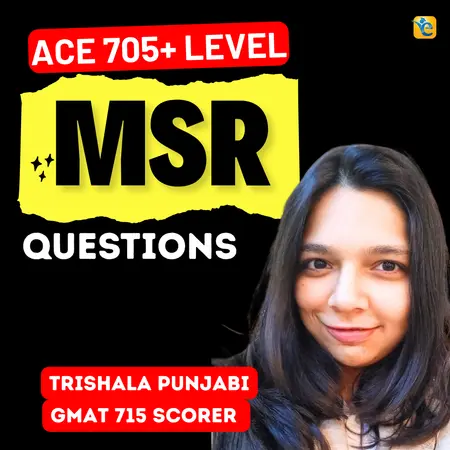Events & Promotions
|
|

GMAT Club Daily Prep
Thank you for using the timer - this advanced tool can estimate your performance and suggest more practice questions. We have subscribed you to Daily Prep Questions via email.
Customized
for You
Track
Your Progress
Practice
Pays
Not interested in getting valuable practice questions and articles delivered to your email? No problem, unsubscribe here.
- Nov 22
11:00 AM IST
-01:00 PM IST
Do RC/MSR passages scare you? e-GMAT is conducting a masterclass to help you learn – Learn effective reading strategies Tackle difficult RC & MSR with confidence Excel in timed test environment - Nov 23
11:00 AM IST
-01:00 PM IST
Attend this free GMAT Algebra Webinar and learn how to master the most challenging Inequalities and Absolute Value problems with ease. - Nov 25
10:00 AM EST
-11:00 AM EST
Prefer video-based learning? The Target Test Prep OnDemand course is a one-of-a-kind video masterclass featuring 400 hours of lecture-style teaching by Scott Woodbury-Stewart, founder of Target Test Prep and one of the most accomplished GMAT instructors.
Kudos
Bookmarks
D
Be sure to select an answer first to save it in the Error Log before revealing the correct answer (OA)!
Difficulty:
 45%
(medium)
45%
(medium)
Question Stats:
66% (01:42) correct 34%
(01:54)
wrong
34%
(01:54)
wrong  based on 938
sessions
based on 938
sessions
History
Date
Time
Result
Not Attempted Yet
If one of two parallel lines has 7 points on it and the other has 8 points, how many distinct triangles can be formed using these points as vertices?
A. 168
B. 196
C. 316
D. 364
E. 455
A. 168
B. 196
C. 316
D. 364
E. 455
Kudos
Bookmarks
Official Solution:
If one of two parallel lines has 7 points on it and the other has 8 points, how many distinct triangles can be formed using these points as vertices?
A. 168
B. 196
C. 316
D. 364
E. 455
Note that this is not a Geometry question. While it uses basic knowledge of lines and figures, it is actually a probability and combinatorics question. There are 8 questions within GMAT Prep Focus Edition that use similar principles. Here is one example.
Approach #1:
There are two types of triangles that can be formed:
1. Triangles with two vertices on the line with 8 points and the third vertex on the line with 7 points: \(C^2_8*C^1_7=28*7=196\);
2. Triangles with two vertices on the line with 7 points and the third vertex on the line with 8 points: \(C^2_7*C^1_8=21*8=168\);
Total number of triangles: \(196+168=364\).
Approach #2:
Any three distinct points chosen from the total of \(8+7=15\) points will form a triangle, except for the cases where the three points are collinear.
Therefore, the total number of triangles can be calculated as \(C^3_{15}-(C^3_8+C^3_7)=455-(56+35)=364\). Here, \(C^3_8\) and \(C^3_7\) represent the number of different sets of 3 collinear points possible from the line with 8 points and the line with 7 points, respectively.
Note: The area of a square, rectangle, the volume of a cube or a rectangular solid, and the Pythagorean theorem are not considered by the GMAT as specific geometry knowledge and can still be tested on the exam. There are several questions involving this in the GMAT Prep Focus mocks. Thus, the question above is not about geometry; it's rather on percents.
Answer: D
If one of two parallel lines has 7 points on it and the other has 8 points, how many distinct triangles can be formed using these points as vertices?
A. 168
B. 196
C. 316
D. 364
E. 455
Note that this is not a Geometry question. While it uses basic knowledge of lines and figures, it is actually a probability and combinatorics question. There are 8 questions within GMAT Prep Focus Edition that use similar principles. Here is one example.
Approach #1:
There are two types of triangles that can be formed:
1. Triangles with two vertices on the line with 8 points and the third vertex on the line with 7 points: \(C^2_8*C^1_7=28*7=196\);
2. Triangles with two vertices on the line with 7 points and the third vertex on the line with 8 points: \(C^2_7*C^1_8=21*8=168\);
Total number of triangles: \(196+168=364\).
Approach #2:
Any three distinct points chosen from the total of \(8+7=15\) points will form a triangle, except for the cases where the three points are collinear.
Therefore, the total number of triangles can be calculated as \(C^3_{15}-(C^3_8+C^3_7)=455-(56+35)=364\). Here, \(C^3_8\) and \(C^3_7\) represent the number of different sets of 3 collinear points possible from the line with 8 points and the line with 7 points, respectively.
Note: The area of a square, rectangle, the volume of a cube or a rectangular solid, and the Pythagorean theorem are not considered by the GMAT as specific geometry knowledge and can still be tested on the exam. There are several questions involving this in the GMAT Prep Focus mocks. Thus, the question above is not about geometry; it's rather on percents.
Answer: D
Kudos
Bookmarks
ramalcha
Similar questions:
https://gmatclub.com/forum/how-many-cir ... l#p1050001
https://gmatclub.com/forum/thirteen-dis ... 11705.html
https://gmatclub.com/forum/of-the-12-po ... 11223.html
https://gmatclub.com/forum/the-sides-bc ... 09690.html
https://gmatclub.com/forum/how-many-tri ... 87496.html
https://gmatclub.com/forum/if-three-dif ... 97169.html
https://gmatclub.com/forum/how-many-tri ... 98236.html
https://gmatclub.com/forum/if-the-point ... 44440.html
https://gmatclub.com/forum/on-a-certain ... 41728.html
https://gmatclub.com/forum/d01-183501.html
https://gmatclub.com/forum/set-s-contai ... 39195.html
https://gmatclub.com/forum/s-is-a-set-o ... 61337.html
https://gmatclub.com/forum/m06-183734.html
https://gmatclub.com/forum/let-t-n-be-t ... 69349.html
https://gmatclub.com/forum/how-many-tri ... 82911.html
https://gmatclub.com/forum/how-many-tri ... 54277.html
https://gmatclub.com/forum/right-triang ... 88958.html
https://gmatclub.com/forum/abcde-is-a-r ... 86284.html
https://gmatclub.com/forum/if-4-points- ... 32677.html
https://gmatclub.com/forum/a-e-d-c-b-se ... 05404.html
21. Combinatorics/Counting Methods
- Theory
Math: Combinatorics
Combinatorics Made Easy!
1 hour Combinatorics Video Lesson
Combinations while dealing with similar and dissimilar things
When Permutations & Combinations and Data Sufficiency Come Together
For more:
ALL YOU NEED FOR QUANT ! ! !
Ultimate GMAT Quantitative Megathread
Hope it helps.












